In water injection wells in Saudi Arabia, techniques used to extend the reach of coiled tubing stimulations included use of nitrified fluids and viscoelastic surfactant friction reducer, as well as optimizing the pull-test frequency in open hole.
Faisal I. Beheiri, Mohammad M. Saudi, Sayed A. Metwally, Nayef S. Al-Shammari and Fahad Al-Meshal, Saudi Aramco; Jose Noguera and Leopoldo Sierra, Halliburton
Drilling wells with longer horizontal sections to maximize the reservoir contact has led to many opportunities for well interventions using Coiled Tubing (CT). In most cases, the complexity has pushed the CT interventions to the limits, driving the development of new solutions to extend CT reach to TD in extended reach wells.
The number of these extended wells has grown significantly in recent years in Saudi Arabia, especially in new development fields like the study area discussed in this article, where more than 100 extended reach power water injection wells were placed. For example, the water injection wells in this study area exhibit the typical complexity due to the combination of large-bore tubulars, lower reservoir pressures and long horizontal openhole completions, with lengths between 4,000 and almost 8,000 ft.
During the initial CT interventions, numerous issues arose, such as stuck CT due to pressure differentials and slack-off weight through severe doglegs, tight spots and other obstructions. Extensive knowledge was gained by performing a simulation and study of the horizontal section geometry and analyzing the operational data. Based on the findings, a combination of techniques was introduced to the CT intervention procedure to extend the reach and minimize operational problems and costs.
Key components of the newly implemented methodology were buoyancy reduction, by using nitrified fluids, and friction reduction, by using a new ViscoElastic Surfactant (VES) friction reducer. In addition, combinations of other techniques were employed, such as optimizing the pull-test frequency in open hole and improving CT movement practices. The new cost-effective and reliable methodology allowed maximization of the CT reach up to 8,000 ft, allowing distribution of the acid throughout entire horizontal sections.
METHODS AND LIMITATIONS
The fields are being developed by drilling extended reach horizontal water injection wells (Fig. 1) in the reservoir’s flank to ensure water distribution, optimal sweeping and reservoir pressure support.
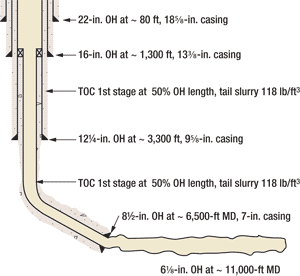 |
|
Fig. 1. Water injection well configuration in the study area.
|
|
Acid stimulation using CT is a challenging process due to the wellbore architecture, length of the horizontal section, reservoir heterogeneity, low reservoir pressure, damage distribution and other factors. For carbonate formations, the success of HCl acid stimulation depends on the placement and acid distribution along the entire open hole.
Although CT represents the most effective placement method in a horizontal section, it has some limitations, especially in complex extended reach wells. An extended reach well is a well with an MD-to-TVD ratio equal to or greater than 2.
The CT limitation on horizontal sections occurs because it can buckle into a sinusoidal or helical shape if the compressive force exceeds a certain critical value for that particular mode of buckling. Helical buckling, by itself, does not damage or plastically deform the CT. Post-buckling lock-up is a limiting condition when running in the hole and can prevent CT from reaching TD. In simple terms, lock-up is a local phenomenon that occurs during RIH when the friction exceeds the axial compressive force. When buckled CT reaches this condition, any further increase in axial compressive force at the top of the helix is lost completely to friction.
Proper modeling of friction factors for CT simulation is necessary to determine whether lock-up occurs or not. There are several techniques that can be used to prevent or delay CT lock-up, including buoyancy reduction, friction reducer, CT size optimization and CT straightening. Some of these techniques were used in the study area.
EVALUATION OF INTERVENTIONS
The first CT interventions presented a significant operational challenge due to the difficulties encountered RIH, as well as stuck situations encountered after the first acid stage contacted the formation.
Problems occurred in 76% of interventions and led to extensive engineering work. Therefore, the focus was on establishing a successful intervention method to overcome these problems in complex and longer horizontal sections. The key involved identifying and understanding the root causes of the problems to establish the solution.
Stuck situations. During the first intervention, several stuck situations were encountered. In most cases, nitrified fluids were used to release the CT. Differential pressure was the main factor due to lower reservoir pressures causing high leak zones. Pumping fluids were nitrified using a gas-to-liquid ratio of 200 ft3/bbl. The nitrification helped to avoid differential pressure problems and apply the buoyancy reduction technique. Adding nitrogen had a positive effect over the stimulation fluid distribution along the horizontal section; the gas bubbles entrapped into the stimulation fluids work as a leak-off control agent.
Difficulties to RIH. Challenges to RIH or slack-off problems in horizontal sections could have resulted from several factors including wellbore trajectory and high openhole friction. In a complex environment, a combination of these factors can make the interventions more demanding.
Directional and measure-while-drilling technologies have critically enhanced the wellbore quality. Nevertheless, tortuosity, high-severity doglegs and hole enlargement still pose serious challenges for CT operations.
In addition, wellbore conditions can also limit CT reach. Solids accumulation creates obstructions that prevent the CT to move further, especially if the open hole is being accessed while injecting the fluid, instead of circulating. To avoid this condition, the stimulation pre-flush fluids were pumped under circulating conditions, helping to remove and clean any solids in the open hole.
To determine actual wellbore friction factors, the real-time data of the first 10 interventions was fed into a computer model to match the actual friction factors and obtain a consistent match. The results showed that CT reached the target depths in wells under the actual friction factors, excluding the effect of sudden azimuth change.
Using the actual deviation survey, a trajectory analysis was performed on those wells in which slack-off problems were encountered. Plots of MD vs. TVD and azimuth were created to analyze the well profile and identify irregularities that could have caused the problems. Sudden changes in azimuth or corner with 90° angle or less were encountered in the problem areas in most wells, Fig. 2. These changes affect the openhole shape and consequently create access difficulties. The same analysis was performed on the problem-free wells, finding better wellbore trajectories with much fewer sudden changes in azimuth or corner, Fig. 3.
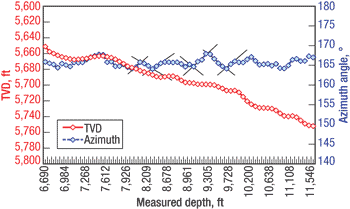 |
|
Fig. 2. Wellbore trajectory with several sudden azimuth changes. TD was reached after problems.
|
|
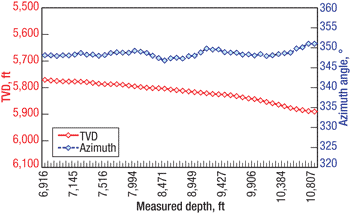 |
|
Fig. 3. Wellbore trajectory without sudden azimuth changes. TD was reached without problems.
|
|
Most of the slack-off problems occurred after CT pull tests in the open hole. After stopping CT in the horizontal section, the momentum lagged, so passing through the sudden changes in azimuth proved slow-going. Therefore, the pull test frequency was reduced from every 500 ft to only one pull test in the openhole section.
A significant decrease in friction was observed when accessing the open holes while circulating nitrified fluid. Figure 4 shows the difference on the weight indicator while RIH with and without circulation in the same well. This technique was adopted as part of the methodology to mitigate the difficulties to RIH. The new VES friction reducer was attempted in the wells where tortuous paths were identified. The use of this fluid generated excellent results and became the key element to minimize the problem and reach TD. Figure 5 shows the effect of the VES friction reducer on an example well.
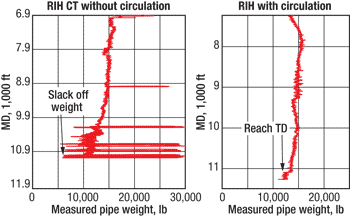 |
|
Fig. 4. Comparison of RIH with and without circulation on the weight indicator for the same well.
|
|
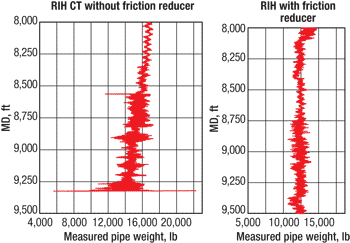 |
|
Fig. 5. Comparison of RIH with and without VES friction reducer for the same well.
|
|
INTERVENTION OPTIMIZATION RESULTS
Since the process optimization was implemented after the first 10 wells, a total of 44 water injection wells with horizontal sections ranging from 4,000 to 8,000 ft have been stimulated. To evaluate the optimization results, the wells were categorized by horizontal section length, Table 1.
| TABLE 1. Summary of interventions |
 |
|
The numbers in Table 1 yield an overall average of 27% of wells having problems, which represents a significant improvement compared with the average of 76% obtained during the first interventions.
Table 2 shows a breakdown of the problems in each well category. The slack-off problems were overcome by increasing the VES friction reducer volume. In two interventions in wells with tortuous paths and several azimuth changes, it was necessary to pump 20% HCl batches to help reach TD.
| TABLE 2. Problems encountered after optimization |
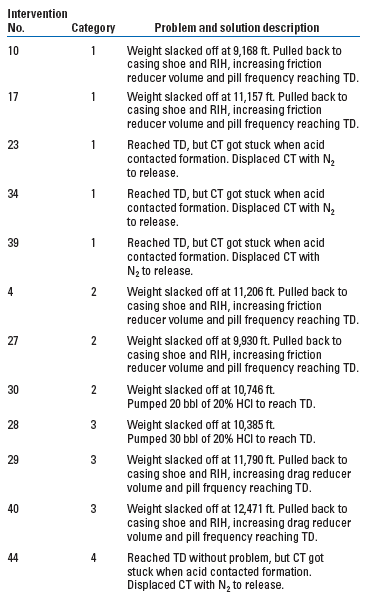 |
|
The developed methodology minimized the number of wells with problems and allowed TD to be reached. Such an achievement significantly improves operational cost and risk management. Below are the key improvement indicators:
Reducing operational time. The average operation time on the problem-free interventions was 30% less than in the wells where problems were experimented on, which not only helped to reduce the operational costs but also to meet the project stimulation schedule.
Prolonging CT lifecycle. Excess cycling on CT strings due to difficulties to RIH and stuck situations reduce significantly the fatigue life of the string, especially in larger CT sizes, such as the 2⅜-in. CT used for these interventions. Therefore, reducing the cycles to extend the CT life and prevent a fatigue failure was one of the most important elements of optimization. The implementation resulted in a 20% increase in the total running length and total jobs per string.
Eliminating the need for a CT tractor. Cost avoidance was realized by canceling the plan to use a CT tractor. After many problems in the wells with short horizontal sections, it was not expected that TD could be reached without mechanical assistance on Category 3 and 4 wells. However, the developed methodology allowed CT to extend through the whole horizontal section without the tractor, eliminating a significant expense.
In addition, a substantial reduction of operational risk and personnel exposure to at-risk conditions was achieved by minimizing the slack-off and stuck situations based on the unsafe conditions associated with tubing failures due to excessive slack-off or over-pull.
A slight modification of this process has been used in wells with horizontal sections longer than 8,000 ft with outstanding results, which will be presented once stimulation of these wells is completed.
CONCLUSIONS
The use of nitrified fluids minimized the differential pressure problems observed during the initial interventions and helped to extend the CT due to buoyancy effects. Circulating the well before accessing the open hole and use of the new VES friction reducer significantly reduced the drag in the openhole section, which helped to reach TD in all well categories. A 30% reduction of operational time was observed after the optimization process was implemented. A 20% improvement of CT fatigue life was observed after the optimized intervention process was implemented. Full openhole coverage was achieved using the optimized intervention process. Minimizing the slack-off problems and stuck situations reduced the operational risk and personnel exposure to risky conditions. 
ACKNOWLEDGMENTS
The authors thank Saudi Aramco management for granting permission to publish this paper. Special thanks and appreciation to Bangkong Sabut, Rifat Said and Abdulrahman Al-Mulhim of Saudi Aramco, who contributed to the success of these interventions, and to Ademar Galvan, Homero Guerrero, Yasser Kamal, Askar Atanayev and Albert Bakhtiyarov of Halliburton, who participated actively in the field implementation. This articles was prepared from SPE 116843 presented at the Abu Dhabi International Petroleum Exhibition and Conference held in Abu Dhabi, UAE, Nov. 3–6, 2008.
BIBLIOGRAPHY
Ballah, K., “Coiled tubing extended reach technology,” SPE 30404 presented at SPE Offshore Europe, Aberdeen, Sept. 5–8, 1995.
CTES LC, “Coiled tubing manual,” 2000.
Ismail, G. et al., “Ten years experience in horizontal application and pushing the limits of well construction approach in upper Zakum Field (offshore Abu Dhabi),” presented at the 9th Abu Dhabi International Petroleum Exhibition and Conference, Abu Dhabi, UAE, Oct. 15–18, 2000.
Maurer Engineer Inc., “Coiled tubing technology manual,” 1993–1994.
Nasr-El Din, H. A., Arnaout, I. H., Cheson, J. B. and K. Cawiezel, “Novel technique for improving CT access and stimulation in an extended reach well,” presented at the SPE/ICOTA Coiled Tubing Conference and Exhibition, The Woodland, Texas, April 12–13, 2005.
Stuart, D. et al., “New drilling technology reduces torque and drag by drilling smooth and straight wellbores,” presented at the SPE/IADC Drilling Conference, Amsterdam, Feb. 19–21, 2003.
|
THE AUTHORS
|
 |
Faisal Ibrahim Beheiri is an Engineering Supervisor at Saudi Aramco. He also holds other positions including HSE Advisor and Petroskills Curriculum Advisor. Mr. Beheiri graduated with honors from Montana Tech of the University of Montana with a degree in petroleum engineering in 1999, and earned a master’s degree in oil and gas engineering from the University of Western Australia in 2006. He has published 11 technical papers.
|
|
| |
Mohammad Mohammad Saudi is a Petroleum Engineer at Saudi Aramco operating in Saudi Arabia.
|
|
| |
Nayef Saud Al-Shammari is a Superintendent at Saudi Aramco operating in Saudi Arabia.
|
|
| |
Fahad Al-Meshal is a Petroleum Engineer at Saudi Aramco operating in Saudi Arabia.
|
|
| |
Jose Noguera is a Technical Engineer for Halliburton Energy Services Inc. Mr. Noguera has seven years of experience in coiled tubing and well interventions working in Venezuela, Saudi Arabia and Indonesia. He earned a BSc degree in chemical engineering at Universidad Metropolitana in Caracas, Venezuela.
|
|
| |
Leopoldo Sierra is a Petrochemical Engineer at Halliburton Energy Services, where he has worked for more than 30 years. He graduated in 1978 from the National University of Engineering in Lima, Peru. Mr. Sierra has worked in stimulation and reservoir engineering services in Peru, Venezuela, the US and Saudi Arabia. He is currently assigned to Halliburton Saudi Arabia as Senior Technical Advisor for stimulation and water control services. He has authored and co-authored many technical papers and owns more than four patents.
|
|
|










